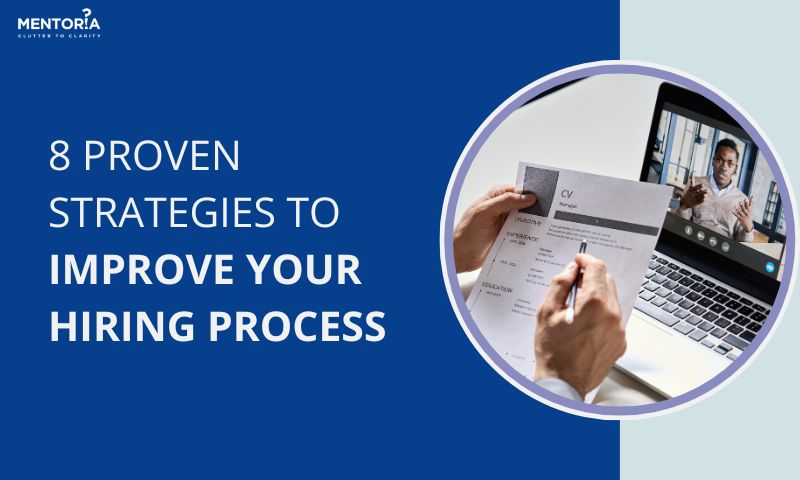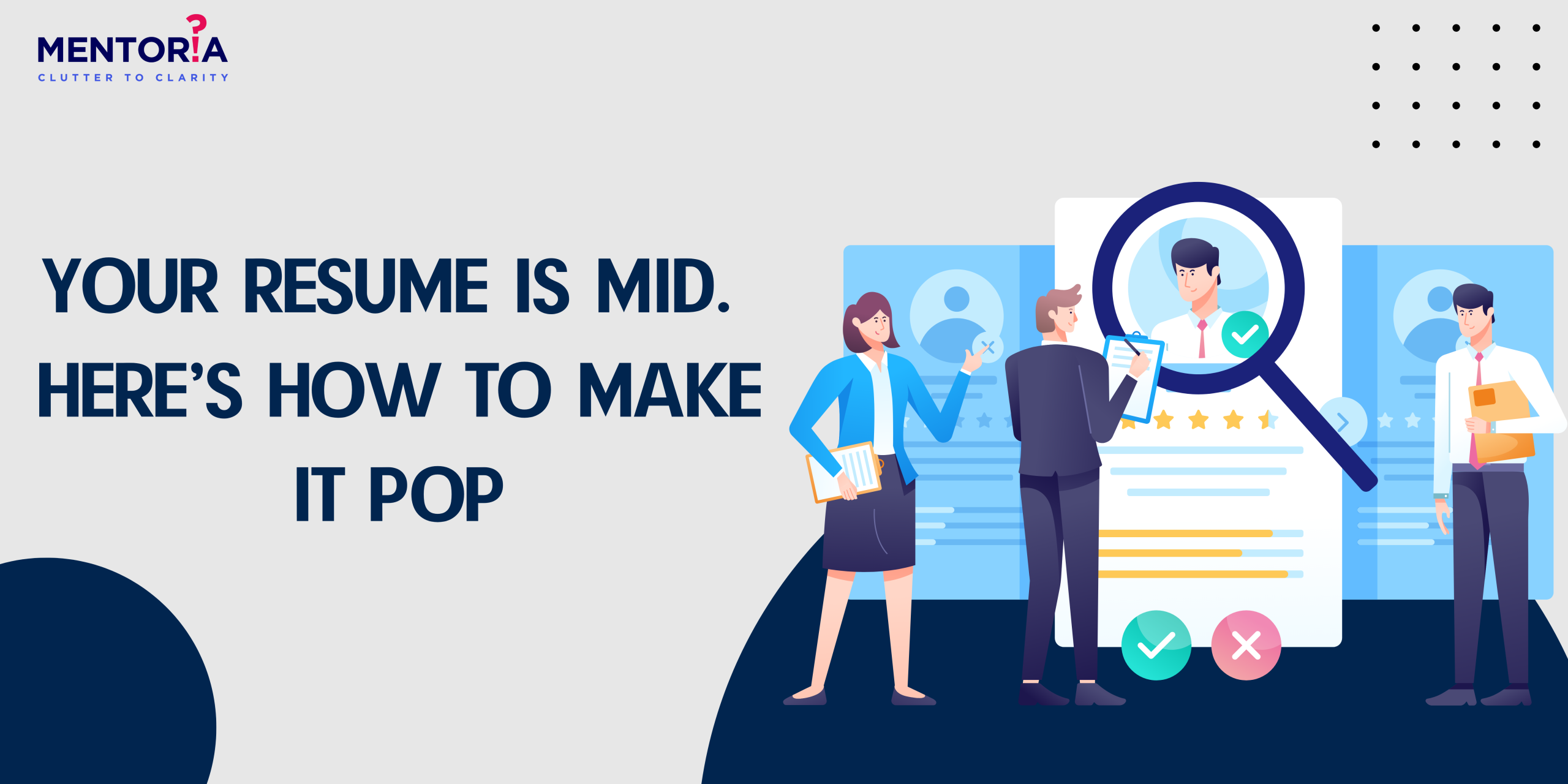8 Proven Strategies To Improve Your Hiring Process

Jump to Section
Let’s be honest: finding and choosing the right candidate for a job is not as simple as it may seem at first. It’s not just a matter of looking at a list of candidates and thinking, “Yep, that person will do.”
Instead, there are multiple steps involved in the employee selection process. You have to create a hiring plan, write a job announcement, conduct interviews, run background checks, and finally send out the offer letter, among other things. If you’re an employer, HR representative, or recruiter, you probably don’t have the time to delve into all the intricate details of this process.
Whether you’re looking to hire an intern, fill positions in your rapidly growing startup, expand your sales team, or increase your workforce significantly, we’ve got you covered. In this article, we’ll provide you with 8 valuable tips that can enhance your recruitment abilities and make you stand out from the competition. These tips are derived from the proven practices of successful recruiters across different industries and sectors. By adopting these habits, you’ll be able to effectively attract, engage, and hire top-notch talent for your organisation. Let’s dive in.
Define The Requirements For Successful Hiring
Before even writing the job ad, it’s important to understand that good recruiting starts with careful planning. Many companies make the mistake of noticing a staff shortage in a specific area, consulting with the board, and then hastily putting together a job ad for a jack-of-all-trades. However, this approach has two major drawbacks.
- It tends to discourage applicants who have a realistic understanding of their skills and qualifications.
- It inevitably attracts applications from individuals who may not meet all the requirements but possess an unwarranted level of confidence.
In essence, it turns the recruitment process into a game of chance.
To avoid falling into this trap, it’s crucial to craft a job description that includes specific and realistic requirements that all applicants can relate to. Consulting with colleagues and superiors beforehand will help you differentiate between mandatory and optional qualifications, resulting in a larger pool of applicants who align with your expectations. Some points to keep in mind.
- Job Analysis: Take the time to thoroughly analyse the job to figure out exactly what it requires. This means gathering information from different people involved, like hiring managers and team members, to get a complete understanding of the role.
- Set Selection Criteria: Establish clear criteria for selecting candidates based on the job analysis. This means figuring out the essential and desirable qualifications for the role and ranking them in order of importance. By doing this, recruiters can effectively evaluate candidates and make informed decisions.
- Communicate: Make sure everyone involved in the hiring process understands what is expected for the position. This includes recruiters, hiring managers, and interviewers. Everyone must know the specific qualifications and attributes they should be looking for in candidates, as well as any non-negotiable criteria.
- Use Screening Tools: Implement different tools and techniques to screen candidates, such as reviewing resumes, using pre-employment assessments, and conducting structured interviews. These tools help ensure that only qualified candidates move forward in the hiring process.
How To Implement This Strategy
To implement this strategy effectively, start by carefully planning your recruitment needs. Don’t rush to write a job ad when you notice a staff shortage. Instead, consult with colleagues and superiors to clearly define the qualifications and skills needed for the role. Differentiate between mandatory and optional qualifications to attract the right candidates. Craft a job description that is specific, realistic, and inclusive to encourage qualified applicants and avoid attracting those who may not meet the requirements.
Transmit The Culture Of The Organisation
Today’s employees place great importance on the alignment of the company’s philosophy and mission with their values. This is not a trivial matter for the new generation of workers. These talented individuals want to feel a sense of belonging, make a meaningful contribution, unleash their full potential, and live by their values.
As a result, it becomes crucial to define the values, philosophy, and commitment of the brand, alongside marketing and communications efforts. This allows these aspects to permeate job offers and the overall employer brand. Why? To attract the most dedicated candidates who, if hired, will feel a sense of happiness and fulfilment in being part of the organisation.
Ultimately, all of this leads to increased productivity. Let’s discuss some points related to this.
- Leading by Example: The way leaders behave and act sets the tone for how everyone else should act too.
- Talking About It: When the company talks about its values, goals, and what it believes in, employees understand what’s important to the company.
- Starting from Day One: When new employees join, they learn about the company’s culture right away through training and how things are done.
- Saying Thanks: When the company praises and rewards employees who do things that match its culture, it encourages others to do the same.
How To Implement This Strategy
To implement this strategy effectively, start by defining your company’s values, philosophy, and commitment. Make sure these align with what your ideal candidates are looking for in a workplace. Incorporate these elements into your job offers and overall employer brand messaging. This will attract candidates who are dedicated and share your values. When hired, these employees will feel happier and more fulfilled, leading to increased productivity.
Define Profile And Optimise Description Of The Job Offer
The initial job description is the first point of contact for potential candidates. It should outline the position, required skills or knowledge, location, and even benefits. It’s important to provide additional information about the expectations for the collaborator, such as whether they will be working as part of a team. This extra information is highly valued by candidates. If the job offer is confusing, it can lead to distrust. However, there may still be candidates who apply without knowing if the position is a good fit for them or if their profile aligns with the requirements. This can result in the need to filter out profiles that don’t match the job offer, which adds to the company’s economic costs in terms of time and the length of the hiring process.
- Profile Definition: Figure out exactly what kind of person you need for the job. This includes knowing what skills, experience, and qualities they should have to do the job well.
- Job Description Improvement: Make sure the job ad explains what the job is about, what the person will do, and what they need to know or have. This helps attract the right people who fit the role.
- Highlight Benefits and Culture: Talk about the good things about working in your company, like benefits, culture, and opportunities for growth. This makes the job offer more attractive to potential candidates.
- Use Keywords and Clarity: Use words that match what people are searching for online, so your job ad gets seen by the right people. Also, keep the language simple and clear, so everyone can understand it easily.
How To Implement This Strategy
To implement this strategy effectively, create a clear and detailed job description. Include the job title, required skills, location, and benefits. Provide information about the work environment and whether teamwork is required. This helps candidates understand if the job aligns with their skills and interests, reducing confusion and building trust. A clear job description also helps filter out candidates who are not a good fit, saving time and costs in the hiring process.
Optimise The Candidate’s Experience
Candidate experience refers to how candidates perceive a company’s behaviour during the hiring process. It’s no surprise that when candidates share their negative experiences, it can harm the organisation’s reputation. However, there’s another aspect to consider i.e. the impact on business.
The negative references can lead to a decrease in sales and income, which comes at a high cost. On the flip side, a positive experience can greatly influence candidates. According to the Talent Board study, 77% of candidates are inclined to share their positive experiences with their close circle. Even if they weren’t hired, they are more likely to engage with the company in the future, whether it’s applying for another position, promoting the employer brand, recommending others, or even purchasing products or services. Here’s how to do it:
- Clear Communication: Keep candidates informed at every stage of the hiring process, from application acknowledgment to interview scheduling and feedback. Clear communication helps manage expectations and reduces anxiety for candidates.
- User-Friendly Application Process: Simplify the application process by minimising the number of steps and fields required. Make sure the application portal is mobile-friendly and easy to navigate to accommodate candidates accessing it from different devices.
- Respect and Timeliness: Treat candidates with respect by acknowledging their applications promptly and providing timely updates on the status of their applications. Even if they’re not selected, sending a polite rejection email maintains a positive impression of the company.
- Feedback and Closure: Offer constructive feedback to candidates, especially after interviews, to help them understand areas for improvement and to leave a positive impression, regardless of the outcome. Additionally, promptly closing the loop with candidates who have been selected for the position ensures a smooth transition into the onboarding process.
How To Implement This Strategy
To implement this strategy effectively, ensure that candidates have a positive experience during the hiring process. Treat them with respect and keep them informed about their application status. This positive experience can lead to candidates sharing their experience with others, which can enhance the company’s reputation. It can also encourage candidates to engage with the company in the future, whether by applying for other positions, recommending the company to others, or even becoming customers.
The Interview, Your Questions, Your Preparation
Candidates aren’t the only ones who need to prepare for interviews. In professional recruiting, the HR manager also takes the time to come up with tailored interview questions for each applicant. By analysing the cover letter, you can gather a lot of information about the candidate and get a sense of who they are. During the interview, the goal is to paint a clear picture of the candidate, which can only be achieved by asking specific questions that delve into their technical and soft skills.
One important aspect of hiring is considering the personality of the candidates. Different companies, especially new and dynamic ones, require individuals with varying characteristics compared to traditional companies. By asking questions about their leisure activities, you can determine if the candidate aligns well with the company culture. Additionally, how they interact with colleagues is crucial in daily work. That’s why it’s important to observe their behaviour and assign a small job-related task. If the candidate handles this task with ease during the challenging situation of a job interview, then you can be confident that you’ve found a capable candidate. Here’s how to do it.
- Understanding Job Requirements: Before the interview, HR managers carefully review the job description and requirements to formulate questions that evaluate whether the candidate possesses the necessary skills, experience, and qualities for the position.
- Getting to Know the Candidate: HR managers create questions to gain a deeper understanding of the candidate’s background, career aspirations, and how well they would fit into the company’s culture. This helps determine if the candidate is a suitable match for both the team and the organisation as a whole.
- Assessing Problem-Solving Skills: Tailored interview questions often involve scenarios or situations that are relevant to the job, enabling HR managers to assess the candidate’s problem-solving abilities and how they handle challenges that may arise in the role.
- Evaluating Cultural Fit: The questions are designed to uncover the candidate’s values, work style, and interpersonal skills to evaluate their compatibility with the company’s culture. This ensures that the candidate not only possesses the necessary qualifications but also aligns with the organisation’s values and overall ethos.
How To Implement This Strategy
To implement this strategy, HR managers should prepare tailored interview questions for each candidate based on their cover letter. These questions should delve into both technical and soft skills to get a clear picture of the candidate. It’s also important to consider the candidate’s personality and how well it aligns with the company culture. Asking about their leisure activities can help gauge this alignment. Observing how they interact with colleagues and assigning a small job-related task during the interview can also help assess their capabilities in a practical setting.
Question Your Decisions
Before finalising your decision, it is important to consider the following advice. This advice plays a crucial role in ensuring the correct selection of candidates. It is rare for a single person to make the right decision for an entire company. Although this step may take time, it is worth asking yourself the following three questions in the long run:
- Can you manage the risks associated with your selection? It is nearly impossible to find a new employee who perfectly meets all the requirements of your desired profile. Therefore, hiring managers must make trade-offs and evaluate the risks of different candidates. What could go wrong in the worst-case scenario, and what benefits can the best-case scenario bring to your company? The worst-case scenario should have minimal consequences, while the best-case scenario should offer clear advantages.
- What is the balance between costs and benefits? This calculation is important in the truest sense of the word. Hiring a new employee is always an investment that should yield returns as soon as possible. Does the new employee meet your expectations, and are the expenses reasonable?
- Do your employees support your decision? This question is crucial because your ideal candidate will have to work with the existing team. The hiring process can only start positively if the majority of your employees support your decision.
By asking yourself these three questions, you can protect your company from unmanageable risks, poor investments, and a negative team environment. Here’s How to do it.
- Think about how decisions are made: Take a moment to think about the standards used to evaluate candidates and the factors that influenced the final decision. Consider if any biases may have affected the decision-making process and how to address them in the future.
- Get input from others: It’s always a good idea to gather feedback from everyone involved in the hiring process, such as interviewers, team members, and supervisors. Listening to their viewpoints can offer valuable perspectives and reveal any hidden weaknesses or areas that need improvement in the decision-making process.
- Assess candidate performance: Review how the candidate performed during the interview process and determine if they showed the necessary skills, qualifications, and fit for the role. Take note of any concerns or red flags raised during the interviews and whether they were adequately addressed.
- Explore other options: Consider looking into alternative options or candidates who may have been overlooked initially. Take another look at the pool of applicants to ensure that the best candidate is chosen for the position and that the decision aligns with the organisation’s goals and values.
How To Implement This Strategy
Before making a final decision on a candidate, it’s important to take the time to think about these three questions. First, consider if the candidate is a good match for the company culture and team dynamics. It’s crucial to assess how well their personality and work style align with the company’s values and the existing team, as this can greatly affect their long-term success and job satisfaction. Secondly, evaluate whether the candidate possesses the necessary skills and experience for the role. Consider their qualifications, technical skills, and relevant experience to ensure they have the capabilities required to excel in the position. Lastly, consider whether the candidate will contribute positively to the company’s goals and growth. Assess how their strengths, experience, and potential align with the company’s objectives and future plans, looking for candidates who can make a meaningful impact and contribute to the company’s overall success. Taking the time to reflect on these questions can help ensure the correct selection of candidates and contribute to the long-term success of the company.
Take A Peek Inside The House
Oftentimes, the skills required are already present within the company, you just need to discover which team possesses them. Conversely, if you believe you have the necessary qualifications for a particular role and desire a change, you can also showcase your abilities and advance your professional journey. Let’s discuss some points.
- Discovering Internal Talent: Foster collaboration and communication across departments to uncover the skills and expertise already present within the organisation. By utilising the abilities of current employees, companies can maximise resource allocation, encourage teamwork, and minimise recruitment expenses.
- Showcasing Skills and Advancing Careers: Empower employees who feel they have the qualifications for a different position to actively demonstrate their abilities and express their desire for career progression. This effort not only benefits individuals by facilitating their professional growth and development but also enhances the organisation by nurturing internal talent and fostering a culture of ongoing learning and upward mobility.
How To Implement This Strategy
To put this strategy into action, begin by evaluating the existing skills within your company. Determine which team has the necessary skills for a specific role. This will prevent unnecessary external hiring and make the most of the talent already available. Conversely, if you believe you have the qualifications for a role and are looking for a change, don’t hesitate to demonstrate your abilities. Emphasise how your skills match the role and how you can make a valuable contribution to the team. This approach will assist you in progressing in your professional journey within the company.
Informed Hiring Decisions With Strategic Planning
Once you’ve gathered all the necessary information from the cover letter, CV, and interview, you’ll have a solid foundation for making a decision. Alongside the answers to the three questions, you now have all the results you need to make an informed and objective choice. At this stage, many recruiters worry about the unpredictable consequences that come with any hiring process. However, by having clear information in the job profile, a checklist for each candidate, and specific interview questions, you’ve minimised the risks as much as possible.
So, you can confidently make a clear decision without being overwhelmed by uncertainties. It’s important to avoid long delays at this point, as it can lead to negative consequences. Applicants may receive other offers during this time, causing your pool of potential candidates to shrink.
It’s not necessary to wait for the perfect candidate because they don’t exist. Instead, focus on finding the right candidate, which will be much easier with these helpful tips.
How To Implement This Strategy
In order to put this plan into action, collect all the required details from the cover letter, CV, and interview. Combine this information with the responses to the three previously mentioned questions to make a well-informed and unbiased decision. Having a well-defined job profile, a checklist for every candidate, and specific interview questions will assist in minimising any risks. Avoid unnecessary delays in making a decision, as this may result in losing potential candidates to other job offers. Remember, the goal is not to find the perfect candidate, but rather the most suitable one for the position. By following these suggestions, it will be easier to find the perfect fit for your team.
Empower Your Hiring Process
Here are some easy pointers to remember while creating your recruitment process and selecting candidates for your company. These tips will help you find the perfect candidate who will contribute the most to your company’s success. Finding and recruiting the best talent is always a lengthy process, regardless of how advanced technology gets. However, the effort pays off when the hired candidate brings value to the company and significantly contributes to its growth.
Organisations seeking to optimise the benefits of recruitment can attend Mentoria’s workshops focused on developing a strong hiring plan. Let Mentoria guide your career path. Reach out to Mentoria to unleash the complete power of recruitment for your organisation and boost your team’s achievements.











